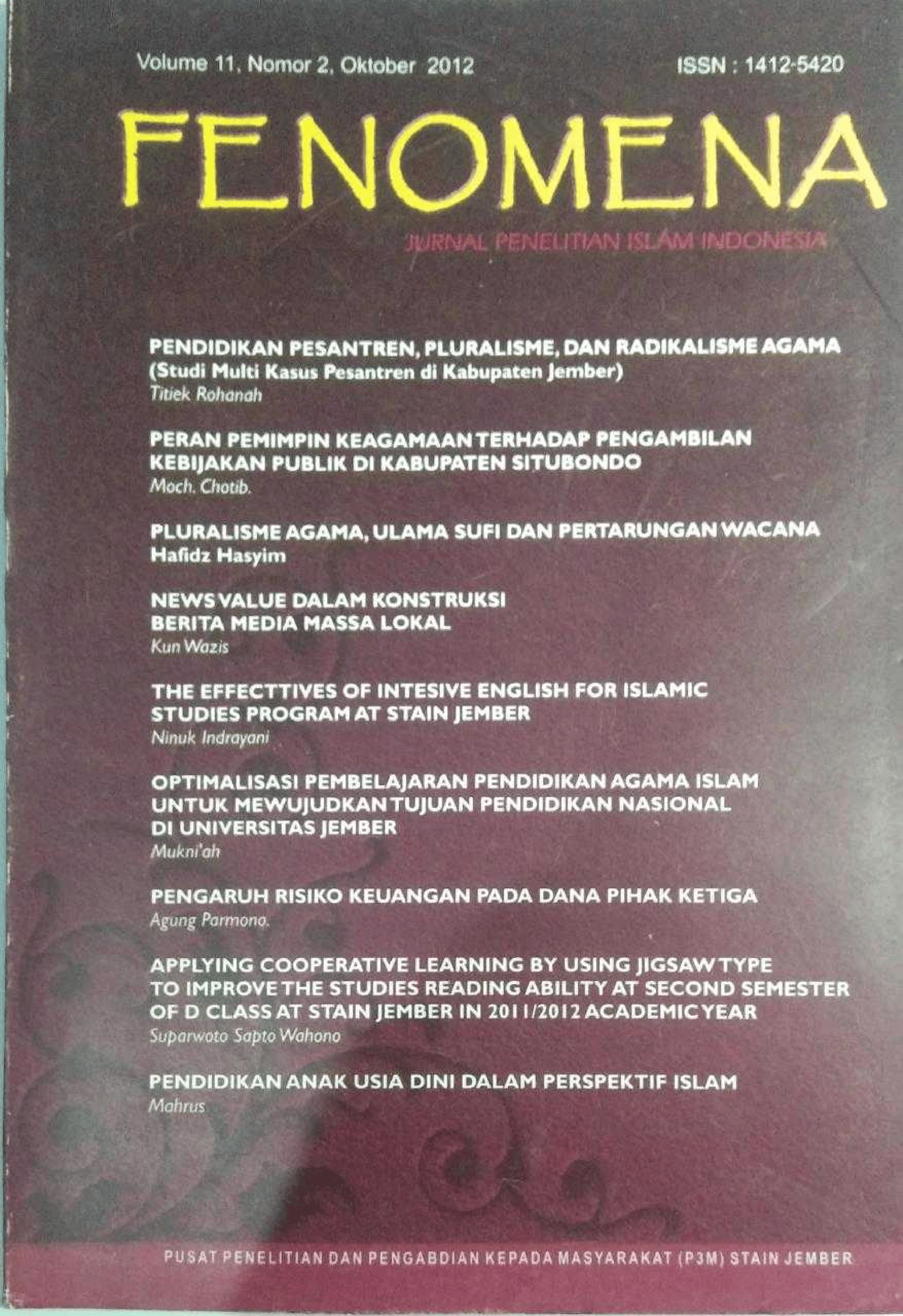Applying Cooperative Learning Using the Jigsaw Type to Improve the Reading Ability of Second-Semester D Class Students at STAIN Jember in the 2011/2012 Academic Year
DOI:
https://doi.org/10.35719/fenomena.v11i2.524Keywords:
Cooperative learning, jigsaw type, reading ability, Pembelajaran kooperatif, tipe jigsaw, kemampuan membacaAbstract
This research was conducted to improve students' reading skills using the jigsaw technique. Reading skills, especially in English, are crucial to master as they enhance knowledge acquisition. Additionally, this technique supports students in comprehending English literature. The conclusion of this study is that the jigsaw technique can improve students' reading skills by dividing them into groups of five members, where each member becomes an expert in their group to convey the content of the text.
Penelitian ini dilakukan untuk meningkatkan kemampuan mahasiswa dalam keterampilan membaca dengan menggunakan teknik jigsaw. Keterampilan membaca, khususnya dalam bahasa Inggris, sangat penting untuk dikuasai karena dapat meningkatkan pengetahuan mereka. Selain itu, teknik ini mendukung mereka dalam memahami literatur berbahasa Inggris. Kesimpulan dari hasil penelitian ini adalah teknik jigsaw dapat meningkatkan kemampuan mahasiswa dalam keterampilan membaca dengan cara membagi mahasiswa ke dalam beberapa kelompok yang terdiri dari 5 anggota, di mana setiap anggotanya menjadi tim ahli bagi kelompoknya untuk menyampaikan isi teks.
Downloads
References
Alderson, J. C. (2000). Assessing Reading. United Kingdom: Cambridge University Press.
Ali, M. (1993). Strategi Penelitian Pendidikan. Bandung: Angkasa.
Arikunto, S. (2006). Prosedur Penelitian Suatu Tindakan Praktek. Jakarta: Rineka Cipta.
Brown, D. (2001). Teaching by Principle. New York: Addison Wesley Longman, Inc.
Cox, C. (1999). Teaching Language Arts. United States: Allyn & Bacon.
Gower, R. (1983). Teaching Practice Handbook. England: Heinemann International.
Iskandar. (2009). Penelitian Tindakan Kelas. Ciputat: Gaung Perdana Press.
Johnson, D., & Roger, T. (1994). An Overview of Cooperative Learning. In J. Thousand, A. Villa, & A. Nevin (Eds.), Creativity and Collaborative Learning. Baltimore: Brooks Press. Retrieved from http://www.co-operation.org/pages/overviewpaper.html
Kagan, S. (1994). Cooperative Learning. San Clemente, CA: Kagan Publishing.
Larsen-Freeman, D. (2008). Teaching and Principles in Language Teaching. China: Oxford University Press.
Lie, A. (2002). Cooperative Learning. Jakarta: PT Gramedia Widiasarana Indonesia.
Nunan, D. (1999). Second Language Teaching and Learning. Canada: Heinle & Heinle Publishers.
Richards, J. C. (2001). Curriculum Development in Language Teaching. USA: Cambridge University Press.
Richards, J. C. (2002). Longman Dictionary of Language Teaching and Applied Linguistics. Malaysia: Fakenham Photosetting Ltd.
Sadeghi, K. (2007). The Key for Successful Reader-Writer Interaction: Factors Affecting Reading Comprehension in L2 Revisited. Asian EFL Journal. Retrieved from http://www.asian-efl-journal.com/Sept_2007_ks.html
Trianto. (2010). Mendesain Model Pembelajaran Inovatif-Progresif. Jakarta: Kencana Prenada Media.
Weil, N. (2008). Vocabulary Size, Background Characteristics and Reading Skills of Korean Intensive English Students. Asian EFL Journal. Retrieved from http://www.asian-efl-journal.com/December_08_nw.html
Downloads
Published
Issue
Section
License
Copyright (c) 2012 Suparwoto Sapto Wahono

This work is licensed under a Creative Commons Attribution-NonCommercial 4.0 International License.















